
Lambdopsalis is an extinct multituberculate mammal from the Late Paleocene of China and Mongolia. It is placed within the suborder Cimolodonta and is a member of the superfamily Taeniolabidoidea. Fossil remains have been found in the Late Paleocene Nomogen and Khashat Formations in Nao-mugen and Bayn Ulan of China and Mongolia, dated to 59-55 million years ago from the Thanetian age. Lambdopsalis bulla is the type species of this genus. The genus and species were named by Chow and Tao Qi in 1978.
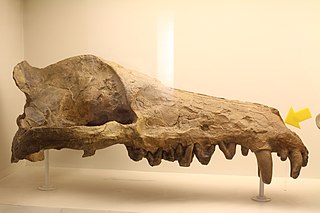
Andrewsarchus is an extinct genus of mammal that lived during the Middle Eocene in China. It contains two species, A. mongoliensis and A. crassum. It was formerly placed in the families Mesonychidae or Arctocyonidae, but is now the sole member of a distinct family, Andrewsarchidae. It is most notable for being estimated as the largest terrestrial, carnivorous mammal, but that status has been disputed.

Uintatherium is an extinct genus of herbivorous dinoceratan mammal that lived during the Eocene epoch. Two species are currently recognized: U. anceps from the United States during the Early to Middle Eocene and U. insperatus of Middle to Late Eocene China.

Hyaenodon ("hyena-tooth") is an extinct genus of carnivorous placental mammals from extinct tribe Hyaenodontini within extinct subfamily Hyaenodontinae, that lived in Eurasia and North America from the middle Eocene, throughout the Oligocene, to the early Miocene.

Miacis is an extinct genus of placental mammals from clade Carnivoraformes, that lived in North America from the early to middle Eocene.

Trogosus is an extinct genus of tillodont mammal. Fossils have been found in Wyoming, California, and British Columbia, and date from the Eocene between 54.8 and 33.7 million years ago. Trogosus was a bear-like herbivore with a large, short skull and flat feet, and had a skull 35 cm (14 in) long with an estimated body weight of 150 kg (330 lb). It had large, rodent-like incisors, which continued growing throughout the creature's life. Judging from the heavily worn molar teeth, Trogosus fed on rough plant material, such as roots and tubers.
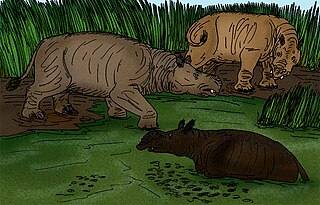
Amynodontidae is a family of extinct perissodactyls related to true rhinoceroses. They are commonly portrayed as semiaquatic hippo-like rhinos but this description only fits members of the Metamynodontini; other groups of amynodonts like the cadurcodontines had more typical ungulate proportions and convergently evolved a tapir-like proboscis.

Mesonychidae is an extinct family of small to large-sized omnivorous-carnivorous mammals. They were endemic to North America and Eurasia during the Early Paleocene to the Early Oligocene, and were the earliest group of large carnivorous mammals in Asia. Once considered a sister-taxon to artiodactyls, recent evidence now suggests no close connection to any living mammal. Mesonychid taxonomy has long been disputed and they have captured popular imagination as "wolves on hooves", animals that combine features of both ungulates and carnivores. Skulls and teeth have similar features to early whales, and the family was long thought to be the ancestors of cetaceans. Recent fossil discoveries have overturned this idea; the consensus is that whales are highly derived artiodactyls. Some researchers now consider the family a sister group either to whales or to artiodactyls, close relatives rather than direct ancestors. Other studies define Mesonychia as basal to all ungulates, occupying a position between Perissodactyla and Ferae. In this case, the resemblances to early whales would be due to convergent evolution among ungulate-like herbivores that developed adaptations related to hunting or eating meat.

Hapalodectidae is an extinct family of relatively small-bodied mesonychian placental mammals from the Paleocene and Eocene of North America and Asia. Hapalodectids differ from the larger and better-known mesonychids by having teeth specialized for cutting, while the teeth of other mesonychids, such as Mesonyx or Sinonyx, are more specialized for crushing bones. Hapalodectids were once considered a subfamily of the Mesonychidae, but the discovery of a skull of Hapalodectes hetangensis showed additional differences justifying placement in a distinct family. In particular, H. hetangensis has a postorbital bar closing the back of the orbit, a feature lacking in mesonychids. The skeleton of hapalodectids is poorly known, and of the postcranial elements, only the humerus has been described. The morphology of this bone indicates less specialization for terrestrial locomotion than in mesonychids.
Xinyuictis is an extinct genus of placental mammals from clade Carnivoraformes, that lived in Asia from the early to late Eocene.
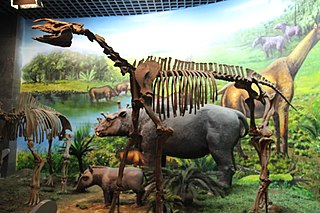
Juxia, ‘joo-she-a’, is an extinct genus of paraceratheriid, a group of herbivorous mammals that are related to the modern rhinoceros. The type species is Juxia sharamurenensis, named by Zhou Mingzhen and Qiu Zhanxiang in 1964. Juxia was around the size of a horse. It lived in Asia during the upper Eocene.
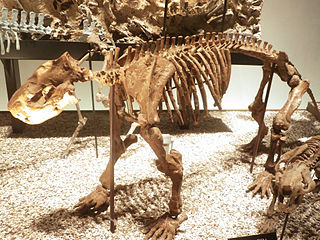
Bemalambdidae is an extinct family of pantodont mammals known from Early and Middle Paleocene of China.

Coryphodontidae is an extinct family of pantodont mammals known from the Late Paleocene to the Middle Eocene of Eurasia and North America.
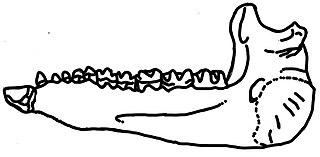
Urtinotherium is an extinct genus of paracerathere mammals. It was a large animal that was closely related to Paraceratherium, and found in rocks dating from the Late Eocene to Early Oligocene period. The remains were first discovered in the Urtyn Obo region in Inner Mongolia, which the name Urtinotherium is based upon. Other referred specimens are from northern China.
Olbitherium is an extinct mammal of the order Perissodactyla from the early Eocene epoch of Shandong, China.
Plethorodon is an extinct genus of tillodont that lived during Early to Late Paleocene. The type species is P. qianshanensis. which known from partial skull and upper teeth that had been discovered by Huang and Zheng at 1987 at Qianshan, Anhui Province, China.
Meiostylodon is an extinct genus of tillodont that lived during Paleocene. The lone type species, M. zaoshiensis, is known only from three isolated teeth found at Zaoshi, Chaling County, Hunan Province in the People's Republic of China. These isolated fossil teeth are stored at the Paleozoological Museum of China.
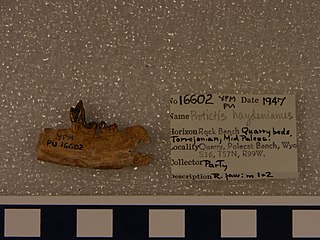
Protictis is an extinct paraphyletic genus of placental mammals from extinct subfamily Didymictinae within extinct family Viverravidae, that lived in North America from early Paleocene to middle Eocene.

Bemalambda is an extinct mammal, belonging to the pantodonts. It lived in the lower-middle Paleocene and the fossil remains have been found in China.
The Dazhang Formation is a geologic formation in China. It preserves fossils dating back to the late Paleocene, including those of plants and mammals. The formation is primarily composed of interbedded marl, oil shale, claystone and glutenite. Depending on the section, the color of the mudstone may vary from green, red-brown or gray-black.

















